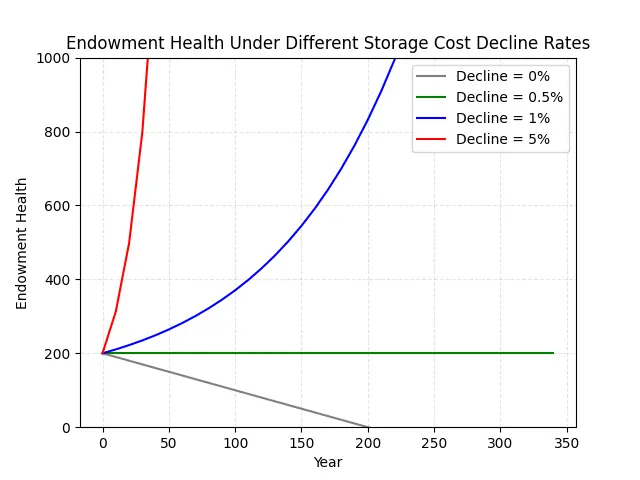Interpretation of Arweave Version 17 White Paper (6): What is a Storage Fund Endowment?

At the core mechanism of #Arweave, there is a very important concept and component, which is the storage endowment #Endowment. The author has described this in a previous article titled “Has Arweave's $AR Become Deflationary?”. This article will provide a more detailed introduction.
✨✨✨✨✨✨✨✨✨✨✨✨✨✨✨✨✨✨✨✨
In Arweave's incentive model, data uploaders are required to pay a transaction deployment fee for permanent storage and provide pre-paid fees for eternal storage to the network's storage endowment in $AR. This fund acts as a payment faucet, and over time, miners will receive payments through this faucet when providing proof of replication for data sets. As storage costs continue to decline, the amount of payment required from the fund to maintain a piece of data will automatically decrease.
Storage Price
The fee paid by users in advance for storing 20 copies for 200 years is calculated based on current costs. The advantage of the Arweave protocol lies in its provision of a very scientific and trustless mechanism to determine the price of obtaining storage space from miners. The estimated number of partitions in the network during a single block B with a specific difficulty d_B can be calculated using the formula from the previous article:

Multiplying this expression by the partition size allows us to calculate the total current storage capacity of the entire Arweave network at the moment of block B:

The amount of $AR awarded to miners and the difficulty of the block can be used to estimate the cost of obtaining storage ------ at the moment of block B, the fee paid for 1 GB of service for 1 minute is:

Where:
- P_m\^(B)= Estimated cost of storing 1 GB of data for 1 minute at the moment of block B
- r_B= Total rewards for block B
Formula Note: The total amount of data stored across the network is calculated in TB, so it needs to be multiplied by 1024 to convert it to GB; the "2" in the denominator represents a block duration of 2 minutes, so it needs to be divided by 2 to convert it to an estimated cost per minute.
Using a single block period to estimate storage prices can result in high instability due to the differences between collected transaction deployment fees and difficulty adjustment algorithms. Therefore, in practice, the network records the difficulty and rewards released over a large number of blocks. These records are used by the network to accurately calculate the cost of obtaining storage from miners over the 6 weeks prior to the block:

Where:
- P_m(B)= Average cost of obtaining 1 GB for 1 minute calculated over 6 weeks.
- h_B= Height of block B.
- n= Number of blocks within 6 weeks (30247*6 = 30,240).
Using these calculations, the network can accurately estimate the cost of obtaining 1 GB of storage within a block period (approximately 2 minutes):

Based on this formula, the protocol calculates the current price for 20 copies of any data D over 200 years as follows:

This is the price charged to users as a pre-contribution for the storage endowment. Over time, miners will receive payments from the fund after proving they have stored the network data sets, and the payment calculation is as follows:

Where:
- r_e(B)= Withdrawal from the fund at block B
- r_i(B)= Inflation rewards released in block B
- r_f(B)= Transaction deployment fees accepted in block B
- P_B(B)= Estimated cost of storing 1 GB of data for one block period at block B
- W= All data sets stored on Arweave at the moment of block B
This formula means that when the total storage cost exceeds the block rewards obtained, fees will be withdrawn from the fund to subsidize miners. However, based on previous data, the result of this formula is negative, indicating that not only will no fees be withdrawn from the storage fund, but a portion of the fees will also be deposited into the fund.
Deflation and Fund Value
Whenever data is uploaded, the Arweave network will transfer a corresponding amount of tokens in circulation to the fund used to pay for the accumulated data storage costs over time (Endowment). The purchasing power of the fund is elastic, changing with the volume of submitted data, storage costs, and token value.
One of the main drivers of changes in fund value is the decrease in storage costs, which leads to an increase in storage purchasing power in proportion, thereby reducing the number of tokens that need to be released from the fund in the future. The rate at which the total cost of actually storing a unit of data declines over a time period is referred to as kryder+. This rate includes changes in hardware prices, electricity costs, and operational costs related to data storage.

Figure 1: The health of the fund is affected by the difference between the protocolized kryder+ rate (0.5%) and the actual kryder+ rate, as well as changes in token prices.
Users pay the current price for the cost of replicating storage for 200 years, so a kryder+ rate of only 0.5% is sufficient to indefinitely sustain the fund without changes in token prices. However, over the past 50 years, the actual rate of decline in storage costs has remained at an average of about 38.5% per year. Given the significant incentives and room for improvement, this trend is likely to continue. Additionally, the difference between the actual Kyder+ rate and the protocolized 0.5% kryder+ rate can be adjusted to provide a wide safety margin for token price fluctuations, which will also lead to deflation in token supply over time.
Decentralized Content Policy
The Arweave network employs a decentralized layered content policy system without centralized control and review. The basic principle of this system is voluntariness: each participant can freely choose the data they want to store and provide, with no mandatory requirements set by the protocol. This system allows each participant in the network to create and operate their own content policies without the need for consensus from others. The result of this practice is the formation of diverse content policy choices, specifically reflected in three different levels:
- Miners: Since miners store data and publicly disclose their content, they are subject to the laws and regulations of any country or region. Therefore, miners in the network can perform any computations on the data they store (including various forms of text, images, videos, etc.) to filter out content they deem illegal or inappropriate. This allows them to avoid storing illegal content that does not comply with local regulations.
- Gateways: Users typically access content on Arweave through gateways. Gateways serve as portals, allowing users and developers to access data in the Arweave network without running their own nodes. Just as miners can choose their own content policies for stored data, gateways can also independently decide which content to index and provide. Moreover, the interoperability of gateways in the network allows users to choose gateways that align with their personal beliefs and values.
- Applications: The final layer of content review that may affect Arweave users is at the application level. Each application built on Arweave data may use additional filters on the content provided in its interface, depending on the developer's code implementation. These application-level content policies can be embedded in the source code of the application itself and stored immutably on Arweave ------ allowing users to trust permanently how the application will conduct content review.
✨✨✨✨✨✨✨✨✨✨✨✨✨✨✨✨✨✨✨✨
About @ArweaveOasis Chinese Channel
An official affiliate responsible for brand building, business development, market activities, and other multidimensional work for the Arweave ecosystem in Asia. Focused on the long-term development of the Asian market, @ArweaveEco









